Bulgarian cuisine: Grilled meats, creative salads and puffed pastries
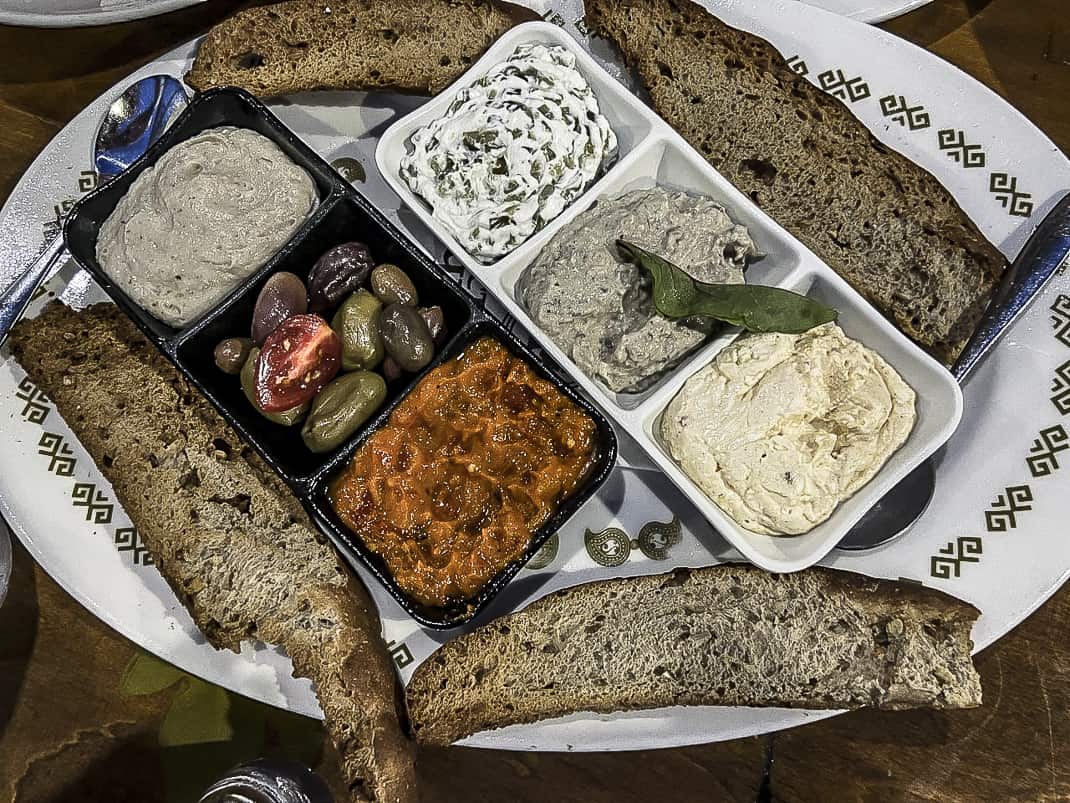
(This is the second of a series of blogs on Bulgaria.)
SOFIA, Bulgaria — “Want to go out for some Bulgarian?”
Never received that request? Neither have I. However, I’d like to do it someday. The trouble is, the world’s gastronomic road map doesn’t have many Bulgarian cuisine rest stops. In fact, I’ve never seen a Bulgarian restaurant. I know New York has a few. So does London. Rila Cafe, the lone Bulgarian restaurant in my previous city of Denver, has closed. So how do you go out for some Bulgarian?
Go to Bulgaria.
I did. Last month I spent a week crisscrossing the country and discovered all new taste thrills. They touch all the taste buds of a Westerner and the spoiled high standards of a resident of Italy, both of which I am. Grilled meats. Grated cheeses. Stuffed pastries and peppers. Fresh salads. Dried sausages. Dripping desserts.
Oh, and Bulgaria is the birthplace of yogurt. Well, at least we know who to blame.

Seriously, I came to Bulgaria to experience a lightly trodden country that has developed all the comforts of the West while still haunted with heavy touches of its communist past. Yet it doesn’t have the tourist mobs of Prague, Budapest and Berlin. What I also came away with was a cuisine that rivals Hungary’s as the most underrated in Europe.
The development of Bulgarian cuisine is more remarkable considering how far it has come. Under communism from 1945-90, a Bulgarian menu could be written on the fringe of a Liechtenstein postage stamp. Meals were limited to whatever food stores happened to sell at the time. In “Street Without a Name,” Kapka Kassabova’s terrific 2008 book about her childhood in Sofia in the 1970s and ‘80s and her return in the 2000s, she talked about life in a cinder block apartment building on a street that really didn’t have a name.
“So what if the butcher only had mixed mince and bloody legs that she wrapped up in coarse brown paper? Or the baker had only two types of bread, white and wholemeal …?”
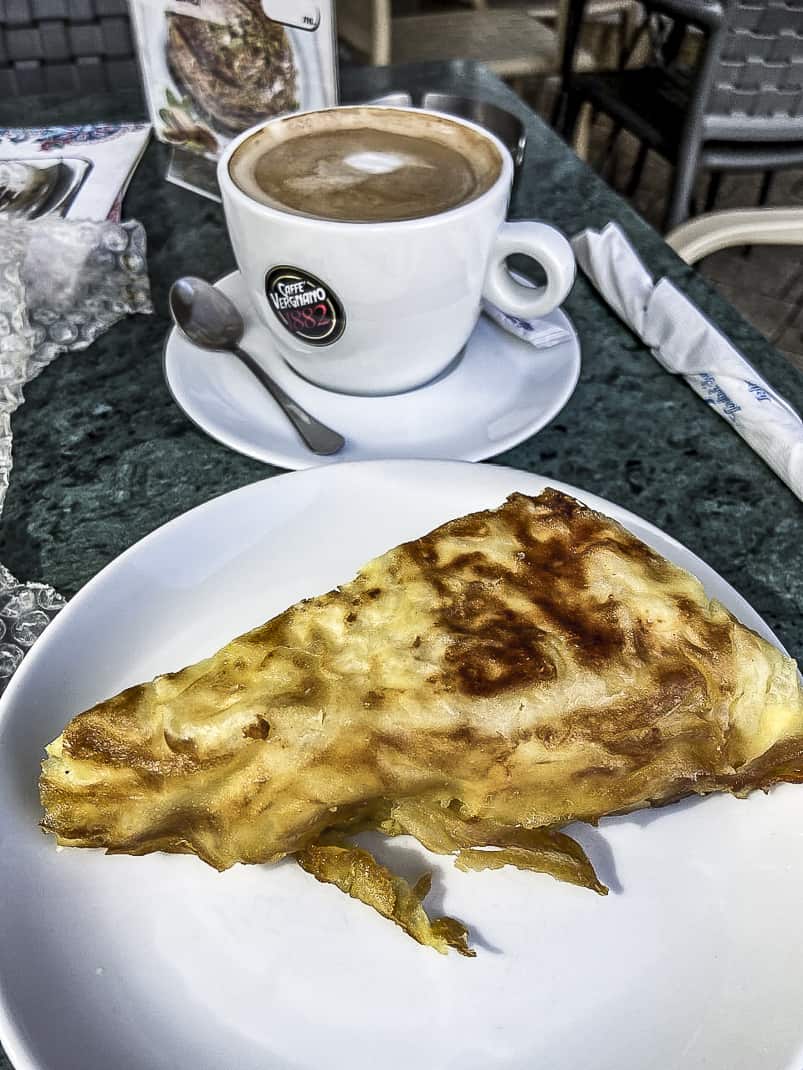
Today, Bulgarian cuisine is not only tasty, it’s healthy. Grilled, not fried. Fresh, not packaged. As I walked streets from the chic shopping boulevards in Sofia to the scruffy back roads along the Black Sea, I don’t remember seeing any obesity. It’s there. It just isn’t as obvious as many places. According to the World Population Review, 25 percent of Bulgaria’s 7 million people are classified as obese. That’s only 53rd in the world. (The U.S. is 12th at 36.2 percent, by far the highest of any industrialized country; Italy is at 19.9 and ranked 108th.)
Balkan Bites
On my first day in Bulgaria I dove into its cuisine in the form of a free food tour called Balkan Bites (info@balkanbites.bg). I met tour guide Ivo, a healthy, husky, 32-year-old Sofia native, along with a French tourist and Spanish tourist at a pretty park in the center called Crystal Garden. It boasts dozens of tall, shady trees, park benches and an open air bar with the egalitarian communist name Bar Bar.

Underneath the park’s pretty exterior is a bloody past. It was on a street running along this park where Stefan Stambolov (1854-95), one of the founders of modern Bulgaria and arguably its greatest prime minister, was attacked by assassins. A gunman shot at his horse-drawn carriage and three others captured him as he ran away. Knowing he always wore a bulletproof vest, they hit him in the head and face with what else they had handy.
An ax.
He escaped but died three days later. The park has a giant sculpture of Stambolov’s head — with a slash down the middle and a big scar on his cheek.
“It shows how tough we Bulgarian men are,” Ivo said with a smile.
Bulgarian cuisine history
Ivo then gave another history lesson. This one is about his country’s cuisine which follows the same road map as the many peoples that conquered it. The Thracians who first settled Bulgaria were heavily into warfare but in 4,000 B.C. they developed wine and cheese, which it turns out go quite well as an after-slaughter aperitivo.
In the 6th century A.D., the Slavs arrived from the North and brought their pastry recipes and introduced mushrooms to the landscape. One century later, semi-nomadic tribes from Asia brought animals, which began Bulgaria’s strong meat tradition, and fermented milk which started its disgusting yogurt tradition.
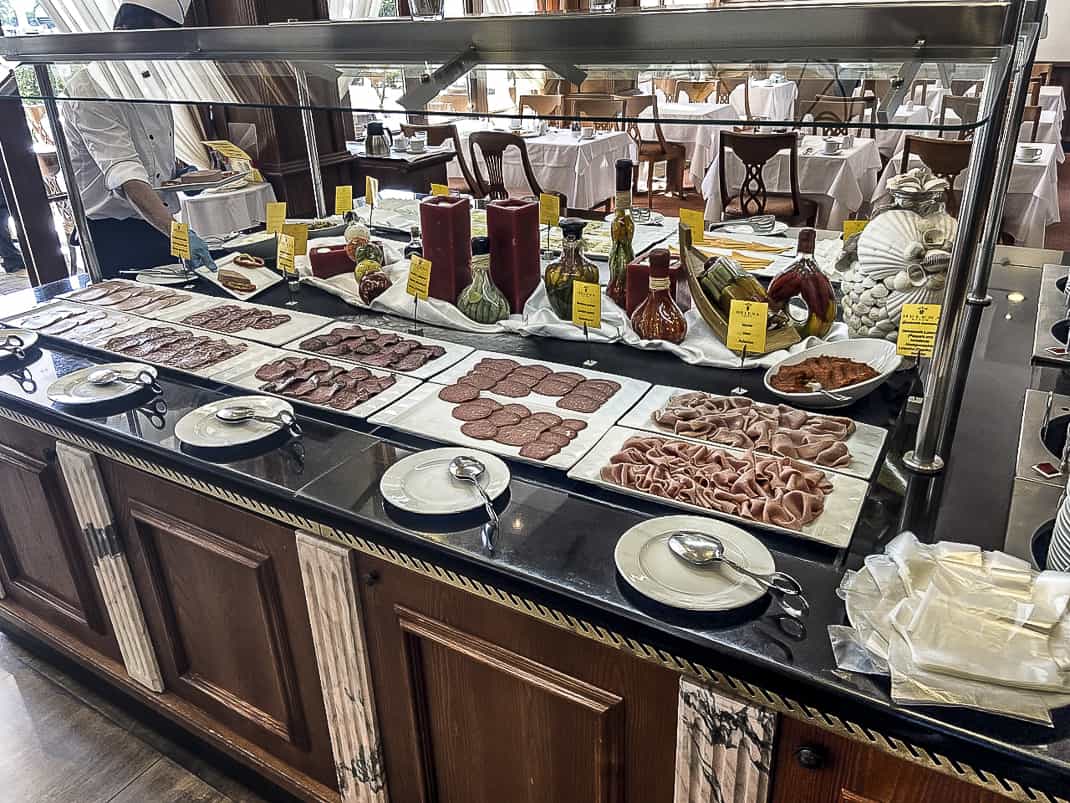
The Ottomans came in the 14th century for a stay of 500 years. When they weren’t beating the Bulgarians like burros, they brought the delicious dessert baklava, rice pilaf, shish kabob and gyuvech, a thick vegetable stew.
Under the Ottomans, Bulgaria became a melting pot of cuisines with tomatoes, peppers, corn, potatoes, beans and pumpkins coming from the Americas. Ottomans brought spices and cucumbers came from India, becoming the basis of what’s considered Bulgaria’s national dish: salata shopska, a big raw salad with cucumbers, onions, bell peppers, tomatoes and sirene, a white brine cheese similar to Greece’s feta.
Yogurt
However, Bulgaria’s international claim to fame is many Bulgarians say it’s the birthplace of yogurt. It’s also a claim to shame, depending on your stance on sour, fermented milk. As one American comic once wrote, “If you don’t understand the power of advertising, how do you explain why so many people actually like the taste of yogurt?”
Plain yogurt is ghastly. It tastes like milk that sat on a porch the entire month of July in rural Mississippi. It’s more sour than sauerkraut in lemon sauce. A drunk violinist hits fewer sour notes. I hate it. I’ll take the industrialized, fruit-flavored yogurts with more preservatives than some of the more healthy Twinkies.
But one man’s hell is another man’s paradise. In 2019 the world bought nearly $113 billion worth of yogurt, and Bulgaria is the reason.
Ivo explained that in 1905 a Bulgarian doctor named Stamen Grigorov identified the bacteria in peasants’ milk and named it lactobacillus bulgaricus. Two years later, Bulgaria wound up with the longest lifespan in Europe. That’s when another doctor, Ilya Mechnikov, studied Grigorov’s work and concluded that the bacteria was the reason for it.
“When I was a baby, I ate two kilograms of yogurt a day,” Ivo said, “so I might be around a very long time.”
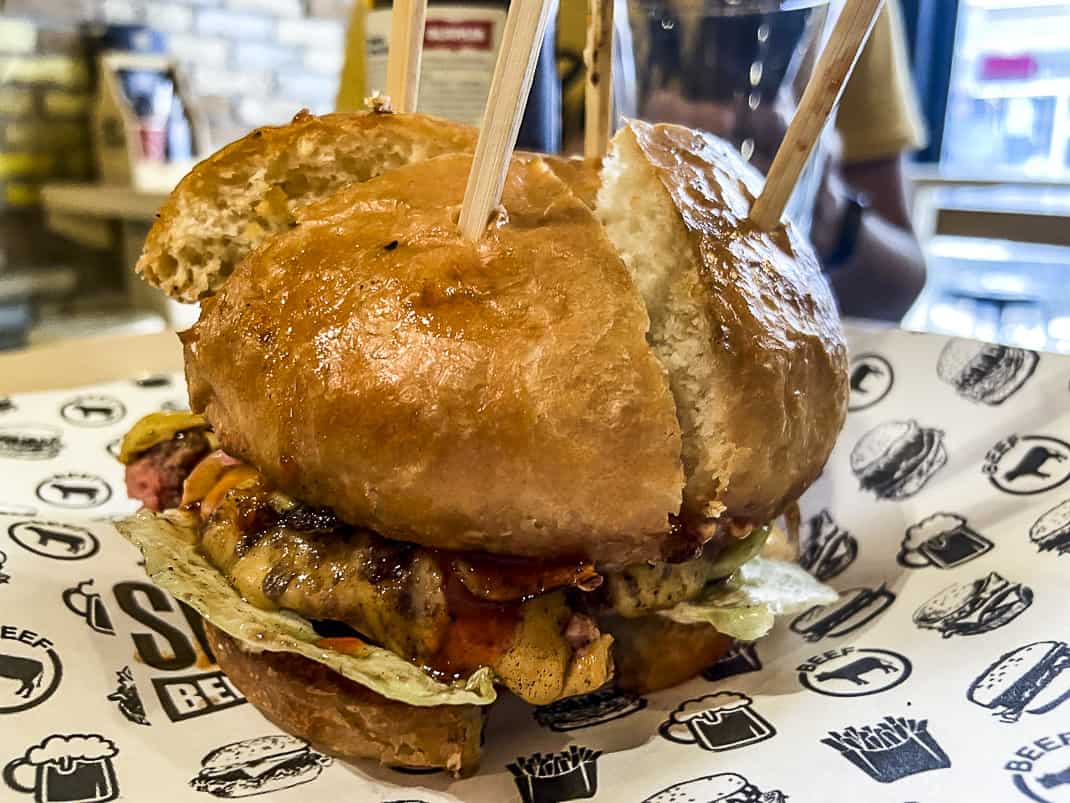
The tour
After a stop at a takeaway wine store, we sampled a modern Bulgarian craze: hamburgers. Yes, hamburgers are on many menus in Bulgaria but at Skapto, they’re on another level. An alum of American University of Bulgaria designed a burger using only local products. We all got a quarter burger filled with a meatball, bacon, cheddar, tomato and onion. Yes, it tasted like one in the U.S. but only a designer burger without the grease.
Any Bulgarian on his birthday can come to Skapto and get a free burger.
“It’s a socially responsible company that supports street artists,” Ivo said.
As we walked along to the next stop, I asked Ivo about Sofia’s restaurants during communism. Walking around this beautiful, tree-laden city, it’s hard to imagine it ever looked gray, depressing and cold. On a perfect June day in the high 70s, every street in the center had restaurants and cafes with its outdoor tables full, sharp-dressed waiters scurrying around. Menus propped up on windows and on sidewalks.
The best sign yet: Few were in English. Dining in Bulgaria is definitely a local experience.
Ivo said under communism, Bulgaria’s government-run tourist agency, Balkanturist, wielded all the power.
“They decided what you ate,” he said. “They standardized the menu. They had a recipe for shopska salad. Everybody thinks that’s traditional Bulgarian. It’s not. It’s only 70 years old.”
Balkanturist did start a practice that Bulgarians follow to this day. Every menu item in Bulgaria includes the number of grams. It’s a reminder of what they’re putting in their bodies. No wonder I don’t see any fat people.
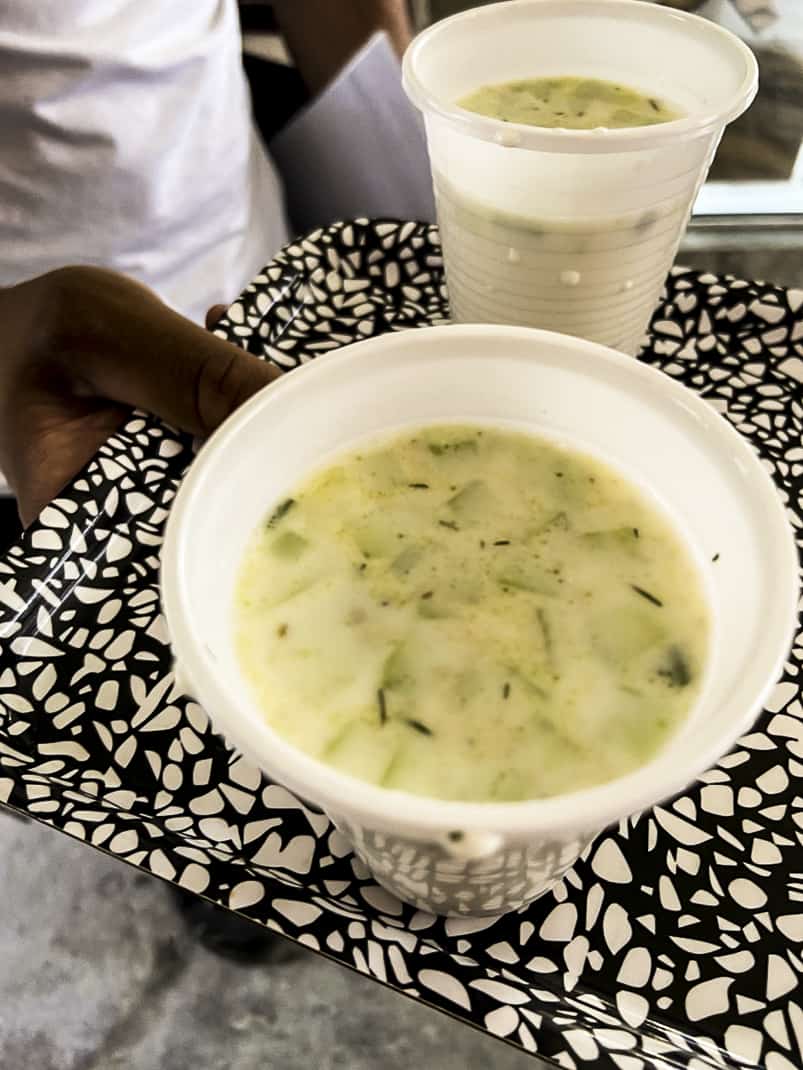
We stopped at a small, unassuming shop called Supa Star. It has 300 recipes for soup. (Supa Star. Get it?) A middle-aged man and two young women in white hats stood behind a counter whipping up a serving of tarator. This is a cold, cucumber and yogurt soup, a Bulgarian diet staple. It sounded awful. It looked worse: a thick, yellowish fluid sprinkled with green bits like floating grass, served in a plastic cup.
As a traveling food writer, I’ve eaten everything from live beetle larvae in the Amazon to roast rat in China. It’s an occupational hazard. I tried it.
I liked it.
The cucumber bits deadened a lot of the yogurt’s sourness, allowing the cucumber’s flavor to burst forth. It was a cool, afternoon snack on a warm day.
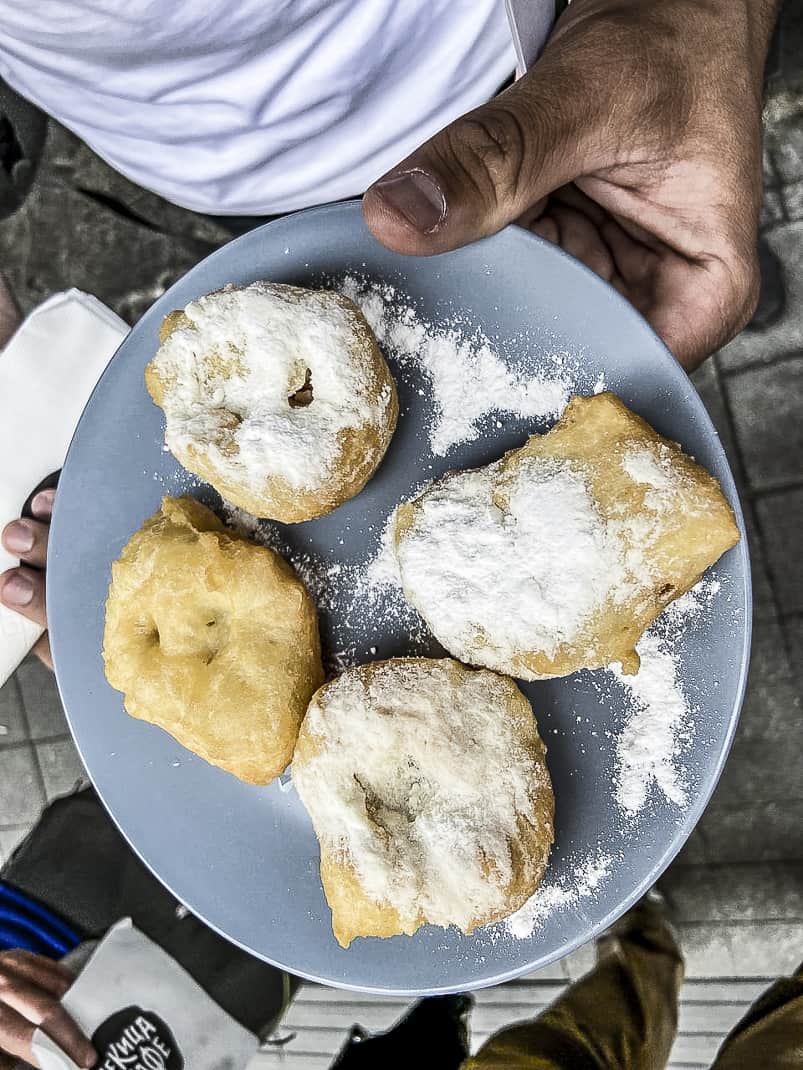
We turned up Sofia’s U. Graf Ignaliev, where a communist-era tram rumbled up the cobblestones. We stopped at a small, sparkling clean shop with pre-made fruit drinks and pastries behind glass cases. A middle-aged blonde woman stood behind the counter behind cakes under glass.
Mekitsa n Kafe is where you get the best mekitsa in Sofia. It’s a traditional Bulgarian dish made from deep-fried dough. Add flour, eggs, a leavening agent, water, salt and oil and you have a puffy, raised, fried dough. Served with powdered sugar, it tastes just like a New Orleans beignet but it’s also eaten with jam, honey, sirene and (sigh) yogurt.
Derived from the Slavic word mek, meaning “soft,” mekitsa has been around since the 5th century and to this day it’s traditional in Bulgaria to eat it with your grandparents. Mekitsa n Kafe takes this tradition seriously.
“They traveled around the country for the best recipe for the homemade dough,” Ivo said.
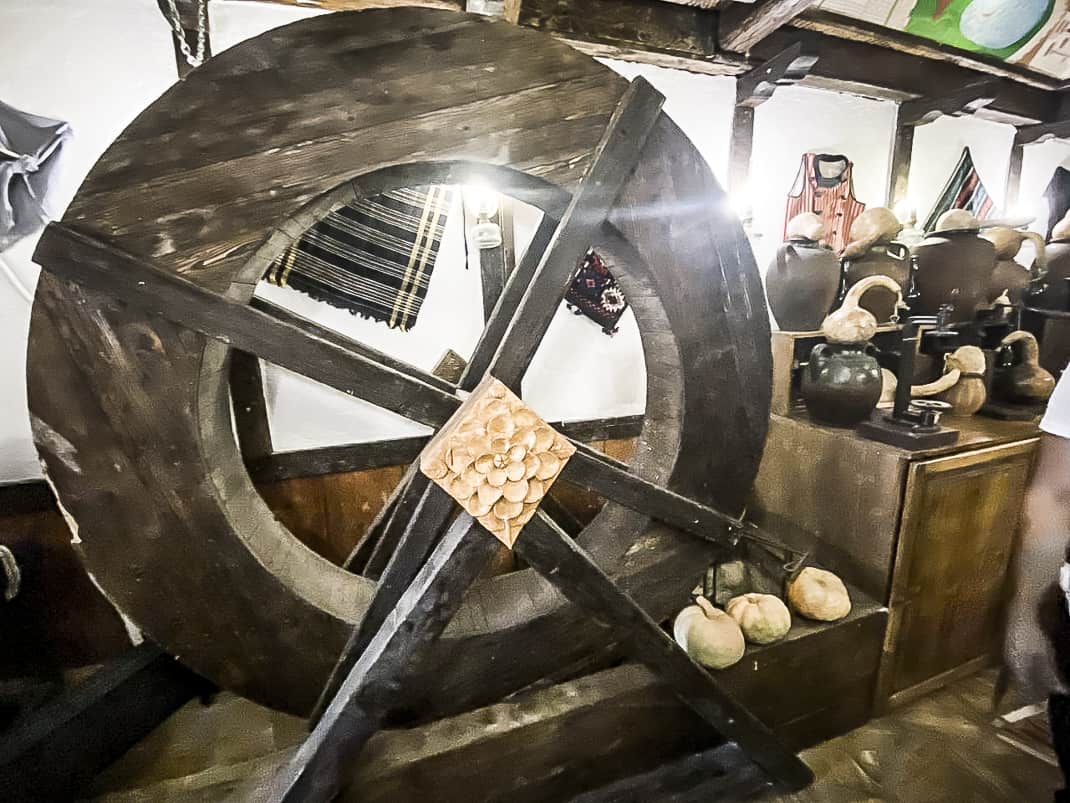
We end the tour at a traditional Bulgarian restaurant with a name a lot harder to digest than its food. Hadjidragana Izbi is the kind of place my research warned me about. By “traditional,” it means it’s dressed up as an old-fashioned Bulgarian eatery from the 19th century. It’s complete with farm equipment such as a water wheel, clay gourds and tools.
With the traditional Ottoman architecture of elaborately designed floor and brick walls and waiters in native garb, it had “tourist trap” written all over it. However, the food wasn’t fake. It was great.
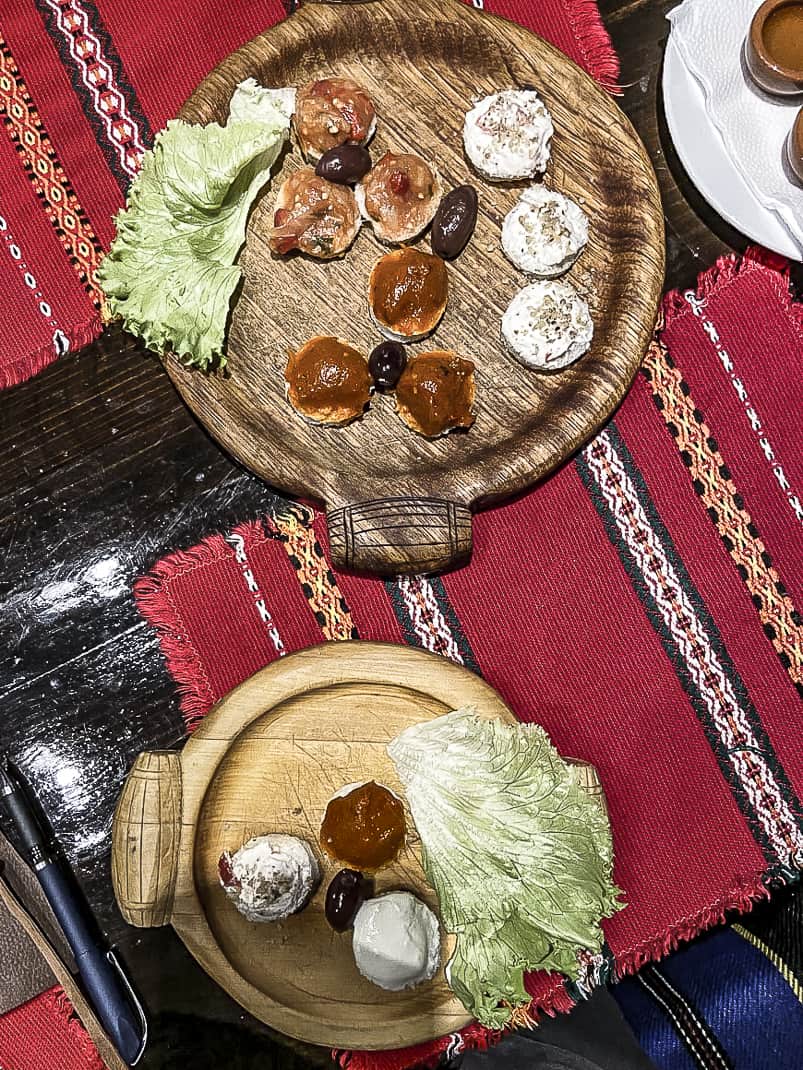
Ivo had the waiter bring out two trays full of Bulgarian appetizers: goat cheese atop puffed bread, katuk (goat cheese mixed with sheep milk seasoned with grilled pepper and walnuts), lyutenitsa (tomatoes and peppers grilled and ground together).
This place couldn’t be too traditional as all the ingredients were fresh. This is a post-communist concept, at least in winter. That’s when most fruits and vegetables weren’t available in Bulgaria. Families would gather them in August and September and freeze them for thawing when the cold winter arrived.
We topped it all off with Pelin, a dessert wine made with dried fruit and herbs, perfect for digestion.
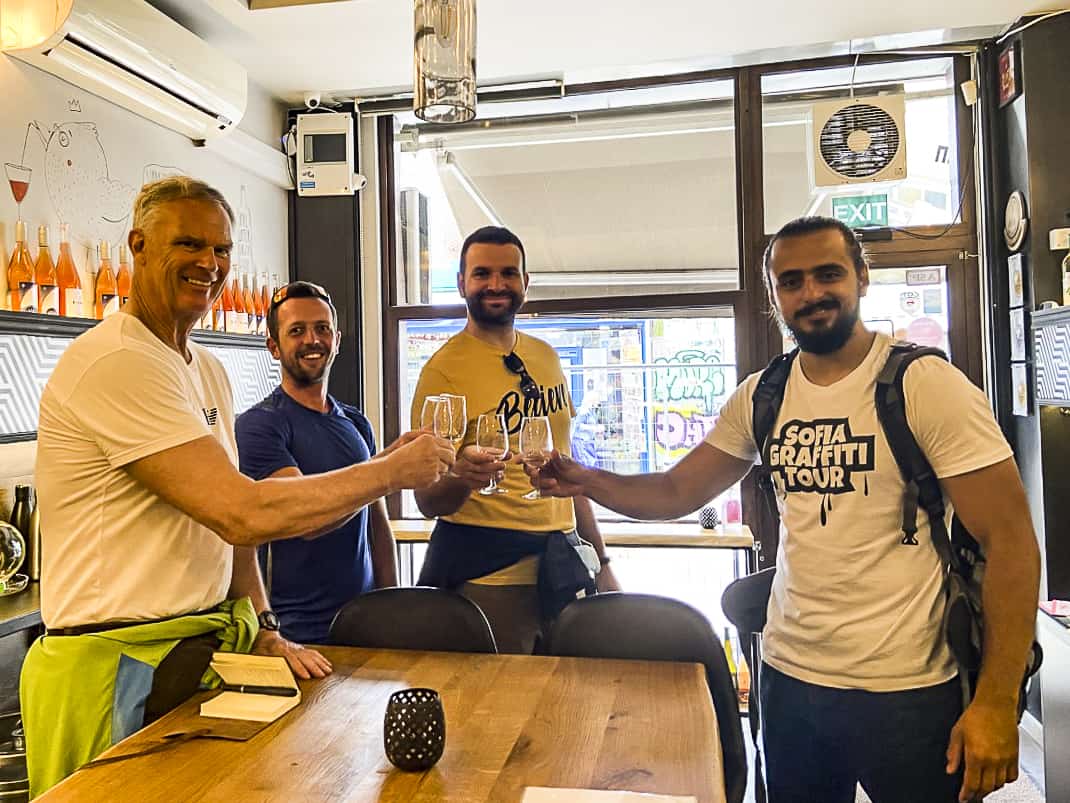
Restaurant scene
One of the great gifts of democracy — besides sexy fashion and cosmetics for beautiful East European women — is the restaurant explosion. Moscow went from an estimated 50 in 1985 to more than 13,000 today.
Sofia has become a superb restaurant town. My first night after I landed, I made a beeline to the highly recommended Momo Bulgarian Food & Wine. While the name sounds like something out of Communist Marketing 101, the food experience was as good as advertised.
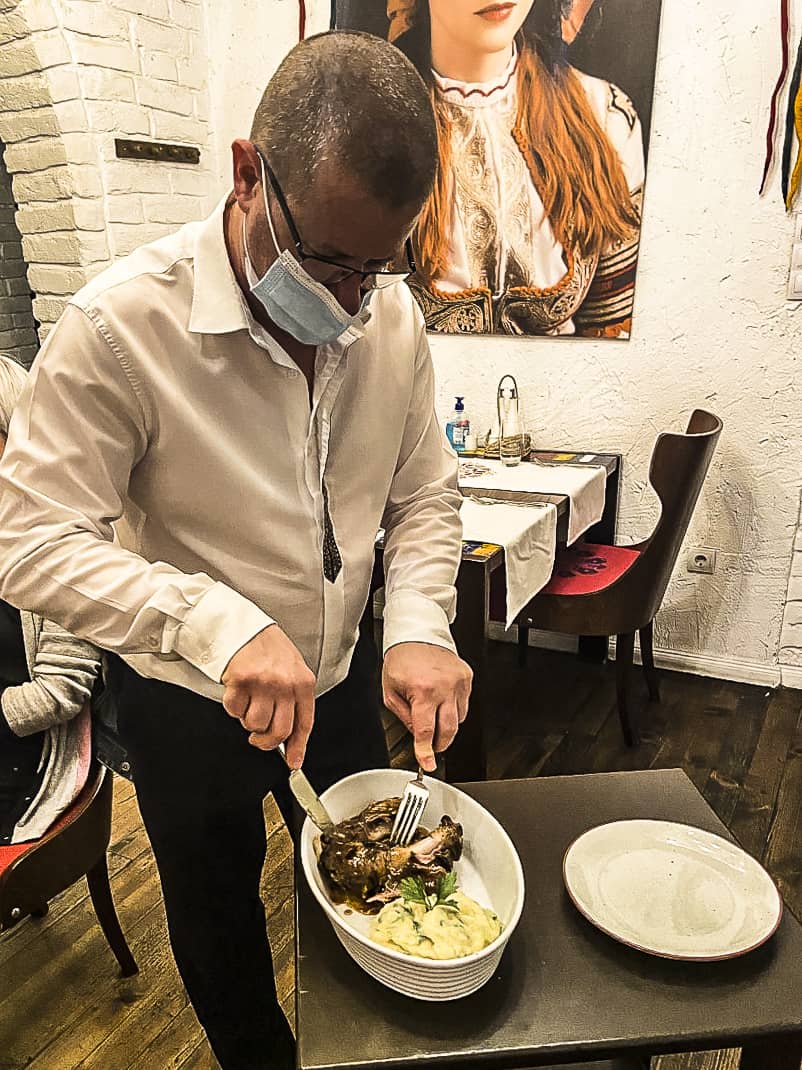
It’s in a large house with a sexy veranda that was still closed from the pandemic. Momo is a modern version of the mehana, a Bulgarian tavern that serves traditional Bulgarian food. Momo has all the traditional Bulgarian favorites, from the long list of salads to the grilled meats.
I had Salata Ivena, a salad with sliced tomatoes topped with roast peppers filled with cheese, garlic and yogurt (surprise!) and sprinkled with lines of parsley oil. So fresh. So cool. So different.
I then ordered the roast pork shank with homemade potato puree in garden spices and roast sauce. It’s a great big chunk of pork in a thick, tangy sauce. The waiter even came out to cut out the bone.
On my last night in Bulgaria, I took an American expat’s recommendation and hit Atelier. It’s a casual but sexy French-style restaurant with a red awning and tables spilling out over a shaded sidewalk. It’s in a ritzy section of Sofia, near the embassies south of the center.
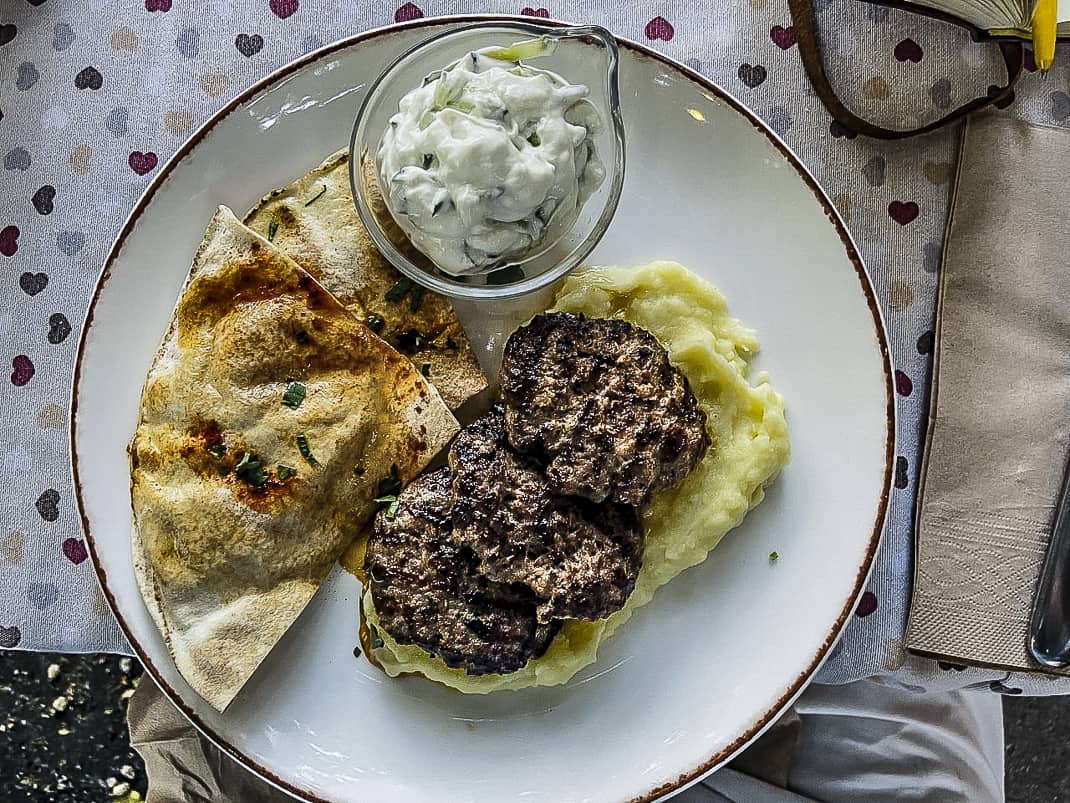
Sitting under a big alder tree on a hot night as Sofia’s steaming summer had just arrived, I had a salad of baby spinach with rucola, strawberries, gorgonzola and walnuts. I followed that with lamb meatballs, slightly flattened with a side of tzatziki cucumber sauce and crispy Arabic bread. Along with a tall Bulgarian beer and a glass of Bulgarian white wine, the total bill was under 20 euros.
In between those first and last days, I had dining pleasures all over the country. My first salata shopska in the ancient town of Plovdiv in the south. At Helena Sands, my five-star resort on the Black Sea, I had spectacular buffet breakfasts and dinners every day. Pancakes with white-chocolate frosting. Five different kinds of sausages. BBQ pork. And every morning I had a banitsa, a flaky puffed pastry filled with cheese and served hot.

In Varna, the modernized port city in the northeast, the place to go is Stariya Chinar. It’s a sprawling indoor-outdoor restaurant right on the Black Sea where I stared out at oil tankers and dined on shopska and bread with five different spreads: cheese with roasted peppers, ground eggplant, tzatziki, roasted peppers with tomatoes and lutinitsa (caviar).
I finished with a great, big meaty slab of pork ribs with nary an gram of fat. I could slice the meat off the bone with a fork.
Living in Rome, I’ll never complain about my dining options. Rome is to food what Amazon is to delivery. But one of these days, probably very soon, I’ll tell myself, “Voglio uscire per qualche bulgaro. (I want to go out for some Bulgarian.)
In case you go …
Where to stay: City Avenue Hotel, Ul. Osogovo 49, Sofia, 359-2-471-5000, www.hotelcityavenue.com, reservations@hotelcityavenue.com. Simple, clean hotel with helpful staff just one subway stop from city center. I paid 38 euros a night for a single room.
Guided tour: Balkan Bites (info@balkanbites.bg) meets daily at Crystal Garden on the corner of Ulitza Rakovski and Boulevard Tsar Osvoboditel. Make reservations 24 hours in advance.
Where to eat: Skapto, Shishman 20, Sofia, 359-700-11-313, https://skapto.bg, 11:30 a.m.-10:30 p.m. Heaping designer burgers from 5.50 euros to 9.50.
Supa Star, Shishman 8, Sofia, 359-2-468-9065, (2) Supa Star | Facebook, 10:30 a.m.-9 p.m. Monday-Friday, noon-9 p.m. Saturday and Sunday. Casual takeaway place for a variety of homemade traditional soups.
Mekitsa n Kafe, ul. Graf Ignatiev 28, Sofia, 359-89-870-9537, https://Mekitsa-and-coffee.business.site, 8 a.m.-7 p.m. Hole in the wall snack shop with traditional mekitsa puffed pastries that date back to the 5th century.
Hadjidragana Izbi, ul. Hristo Belchev 18, Sofia, 359-89-877-5936, www.iz bite.com/bg, 11:30 a.m.-1 a.m. A traditionally decked out classic Bulgarian restaurant specializing in roast meats, including whole lambs and pigs for 250 euros. Single portions of all meats more reasonably priced. Live music Fridays and Saturdays.
Moma Bulgarian Food & Wine, 28 Solunska Street, Sofia, 359-0885-62-2020, www.moma-restaurant.com, moma_restaurant@mail.bg, 12:30 p.m.-11:30 p.m. Classic Bulgarian restaurant with traditional dishes ranging from 4.50 euros for salads to 15 euros for roast lamb.
Stariya Chinar, On port, Varna, 359-879-54-9494, www.stariachinar.com, portvarna@starlachinar.com, 9 a.m.-11 p.m. Hopping, sprawling restaurant on Varna’s huge port on the Black Sea. Starters begin at 3.50 euros, mains 4.50-10. Try the deer hind in clay oven.
Atelier, Asen Zlatarov Str. 16, Sofia, 359-886-20-2717, atelier16@abv.bg. Excellent salads and traditional meat dishes at reasonable prices in a casual setting with a French twist.

